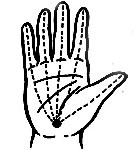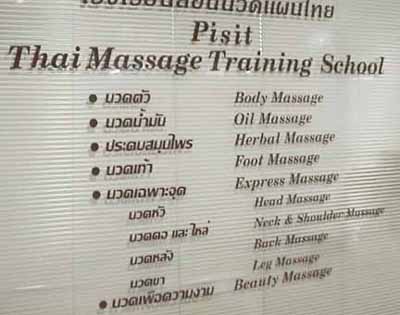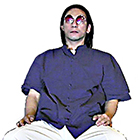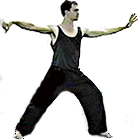DANIEL CARR, CMT
"Having sciatica, a back injury that was shooting intense nerve pain down my leg, led to me to meeting some really benevolent masters of bodywork, both Chinese and Thai, who healed me. It also led to learning masterful bodywork techniques and fixing a lot of deserving people who were in pain.
It is pretty apparent to me that the majority of American massage therapists who are doing Thai Massage, Thai Yoga, or Thai Yoga Massage (the three common names for the same discipline) have been trained in the Northern or "Chiang Mai" style. Most have trained here in the US in seminar format by the others who were lucky enough to be trained in Chiang Mai.
In speaking with these people, it is hard not to get the sense that they feel their understanding of Traditional Thai Massage is definitive, which is quite strange. The Chiang Mai style is used more for relaxation within Thailand, where as the Bangkok styles are more respected for their healing power. They are done quite differently, most noticeably with the amount pressure used. The Bangkok styles would be more akin to "Deep Tissue Massage".
For the layman who is not familiar with these distinctions, randomly choosing a Thai Massage therapist means that they will not be choosing with a real understanding of what is possible or practical for their needs.
Most of these USA Thai Massage practitioners do not understand that the "Bangkok" style exists, nor do they understand that the Bangkok Style has a number of different branches, the "Blind Thai Massage" style being one of these branches. Having studied extensively in both Bangkok and Chiang Mai over the last 13 years, I am quite familiar with these distinctions and use them to achieve the maximum results for my clients.
The highest level practitioners of Thai Massage, the Blind Massage Therapists of Bangkok, know both the Bangkok and Chiang Mai styles and mix them to suit their clients needs. They also have trade secrets for healing that they are typically unwilling to share outside of their blind brothers and sisters. I have also been taught extensively by a Blind Master who has authorized me to teach his system of healing."
My name is Daniel Carr, and I am a long time practitioner of Chinese Martial Arts, Indian Yoga, Eastern bodywork, and Vajrayana Buddhism. I have owned my own full time Kung Fu School for over 7 years, have lived in Asia for over 4 years, and have had the good fortune to have studied with some of great Masters in all of these fields.
My main foundation and discipline came from having studied with Kung Fu Grandmaster Jack Man Wong for 14 years in the San Francisco Bay Area, starting with him at age 19. I was a student at UC Berkeley and was being pulled away from academic endeavors by a fascination with body energetics. It was during this exploration of Chi' in Chinese Martial Arts that led to the study of all of the other disciplines.
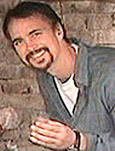 I bring a strong work ethic to all of these arts. All of my teachers are "Old School" Masters, who learned their craft in China, India, and Thailand and are of a similar mind: you perfect your craft by undying allegiance to it. This means you are never satisfied with your current sense of the discipline and constantly strive to higher levels of mastery.
I bring a strong work ethic to all of these arts. All of my teachers are "Old School" Masters, who learned their craft in China, India, and Thailand and are of a similar mind: you perfect your craft by undying allegiance to it. This means you are never satisfied with your current sense of the discipline and constantly strive to higher levels of mastery.
In the final analysis, I let my work speak for itself:
If you don't feel tangible results and improvement in your condition, you don't have to pay.
Thai Massage and Chinese Body Work
The very first statement that should be made here is that I am beyond grateful to the arts of Thai Massage and Chinese Tui Na/bodywork for providing me with the opportunity to have a new body. I would most probably be limping around from all of the sports injuries I have accumulated over the years if not for these ancient arts. These art forms should be respected for their power in reducing the suffering of all those who are in needless physical pain.
Getting The First Tools
In Chinese Tui Na
I received a Traditional Physical Therapy Certificate from the San Francisco College of Acupuncture back in 1990, a course that taught practical Tui Na (translates to "push/pull" with obvious implications to bodywork). A good friend of mine, Dr. Michael Clauson, ran the clinic and was also a student in Sifu Jack Man Wong's Kung Fu class. He knew and worked with many of the best Chinese Medicine people in the Bay Area.
Using his clinic as a backdrop, we had the opportunity to work with many Chi Kung, Kung Fu, and Tai Chi Masters visiting the Bay Area. It was an exciting time, since many of the Mainland Chinese, Taiwanese, and Hong Kong Masters were finally starting to share some of their secrets of bodywork. Many had "family style" secrets in Tui Na that were amazing for fixing martial art training injuries, techniques that had been never shared with anyone outside their own families.
It was during this time that I met Dr. Rong Rong Zheng. Dr. Zheng is the most knowledgeable doctor I have ever met and now runs a thriving practice in San Francisco treating cancer patients, this while doing research at Stanford University. Her background includes being trained as surgeon at John Hopkins in Shanghai, receiving an OMD/Doctorate in Traditional Chinese Medicine, and being the head of the Shanghai Chi Kung Research Institute.
After seeing Dr. Zheng as a patient a number of times for a hip and back injury I had inflicted on myself (thinking I was Hercules and could lift something ridiculous), she eventually revealed to me the logic and application of her Tui Na technique for eliminating scar tissue deposits in the muscles. "Investment in loss" is a concept in Taoism that gets played out in these type of situations: Dr. Zheng demonstrated and explained her technique as she worked on and helped heal my injuries.
The technique, which breaks up scar tissue and liberates the injured muscles while undoing whatever spasms may exist locally, was so effective that I never felt the need to utilize anything else when working on people. People limping into my Kung Fu studio with sciatica, knee and ankle injuries, tight necks and shoulders, etc. would walk out with amazing levels of relief and non-reoccurance of the injuries. If they practiced Kung Fu, Tai Chi, or Yoga at the studio, the results would be even more dramatic.
The story should end here, but there are a number of problems with this particular style of Tui Na technique:
|
In the end, it turns out that Dr. Zheng's Tui Na scar tissue removal technique perfectly compliments Thai Massage. In fact, there are similar scar tissue removal techniques built into the higher level Thai Massage treatments that, while not being quite as fast in removing scar tissue as Dr. Zheng's Tui Na technique, do the job.
A Continuing Journey To Thailand
I visited Thailand for the second time back in 1996 to further my studies in Muay Thai, the Thailand style of Kick Boxing. I had received a few Thai Massages the first time I had traveled to Thailand in 1985, but it was during this trip that I was taken by some of the trainers and fighters I was working with to some expert Thai Massage Therapists.
Their work was so amazing that I vowed I would return again to seek training under true masters of the art. They were able to put me to sleep while using an incredible amount of pressure in their techniques. I felt so flexible and deeply relaxed after these treatments that it defied my understanding of bodywork at that time. With the daily punishment I was receiving in Muay Thai, these treatments provided me with the ability to rebound in a fraction of the normal time.
I starting teaching Kung Fu and Muay Thai again when I returned from Hawaii to the Mainland in 1996. From there, I opened up a formal studio in late 1998 in Los Angeles, which meant putting off going to Thailand until some later date in the future.
As the school became more successful, a certain stress overtook me: while I was getting locked down into the business by the momentum the school was creating, I was also feeling the effects of some old injuries that had I had procured training for and fighting in San Shou matches that had only partially healed. I became increasingly concerned that some of these old injures would be problematic in my training and teaching with the same intensity I always had. It was time to head to Thailand to learn and receive their massage.
I also knew that my grasp on traditional Hatha Yoga was better than most teachers in the US, only fair to good at best, with plenty of gaps in understanding injury rehabilitation. It was impossible to further my studies with the intensity I wanted here in the US, especially with respect to body energetics, so I set a date to travel to both India and Thailand as a pilgrim in search of knowledge in late 2002 and packed my bags.
Thailand: Two Regional Massage Zones
Bangkok and Chiang Mai
It is pretty apparent to me that the majority of Americans who are doing Thai Massage, Thai Yoga, or Thai Yoga Massage (the three common names for the same discipline) have been trained in the Northern or "Chiang Mai" style. Most have trained here in the US in seminar format by the others who were lucky enough to be trained in Chiang Mai.
In speaking with these people, it is hard not to get the sense that they feel their understanding of Traditional Thai Massage is definitive, which is quite strange. None of these practitioners seem to understand that the "Bangkok" style exists, nor do they understand its place and techniques in therapy within the Thai framework.
The highest level practitioners of Thai Massage, typically the blind therapists of Bangkok, know both styles and mix them to suit their clients needs.
Wat Po
"How to get a rudimentary understanding
in the Bangkok Style of Thai Massage"
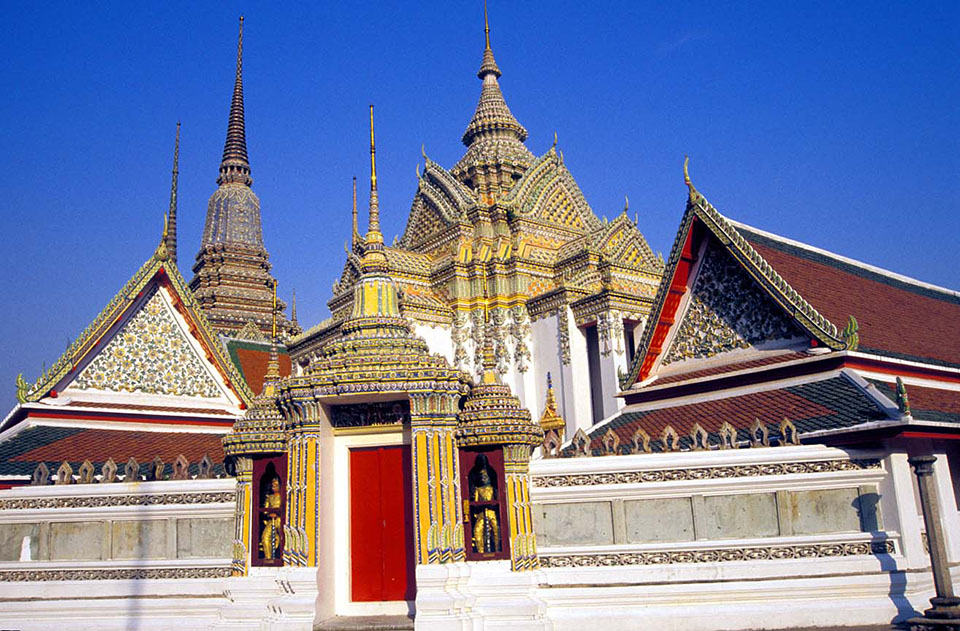
Wat Po is one of the most famous temples in Thailand.
In Bangkok, 95% or more of the foreigners looking for instruction in Thai Massage go to Wat Po to begin their journey. The instruction here ranges from excellent to poor, with some teachers able to communicate easily with the foreigners, others woefully inadequate.
The teachers rotate from giving massages on the temple grounds (mainly to foreigners, as in the below picture) to teaching duties. If you are lucky, you will be placed in a group of 6-8 foreigners during the duration of your training. The Thai's train separately from the foreigners, so they do not face this communication issue.
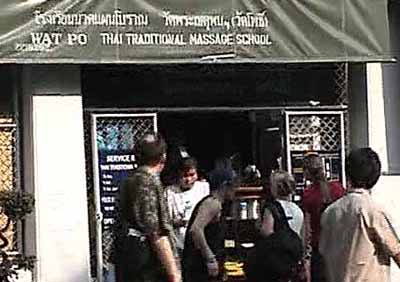
I received certification from Wat Po, but knew that this was just the beginning with respect to a serious effort. While their massage represented the collective efforts of the best minds in Thailand with respect to Thai Massage, the program did not allow enough time for professional bodyworkers to hone their craft. I left there feeling like I had just had a great introduction to Thai Massage.
After completing the program, luck hit me in a way that I couldn't fathom at that moment. The owner of the guesthouse where I was staying while completing program, a shrewish Yuppie of a Thai whose presence I had avoided at all costs, let me know in no uncertain terms that I was basically incompetent after Wat Po, much like all of the other foreigners that had come before me.
The glee with which she said it pushed me a bit, enough so that I challenged her to let me know where I could receive a real education. She did, which baffles and amazes me to this day.
"Zounds, sir, you are one of those that will not serve God, if the devil bid you."
-Iago to Branbantio, Othello, William Shakespeare
Not me...she told me where to go, and I went: Pisit Thai Massage.
Pisit Thai Massage
"Where do the blind go to learn massage?"
Ajahn Pisit Benjamongkonwaree was famous in Thailand for teaching the blind. His school and clinic were always busy, as his blind massage therapists were considered to some of the best in Bangkok. Ajahn Pisit was regularly advising and consulting the government on teaching the blind and had a program that was subsidized by the Thai Government.
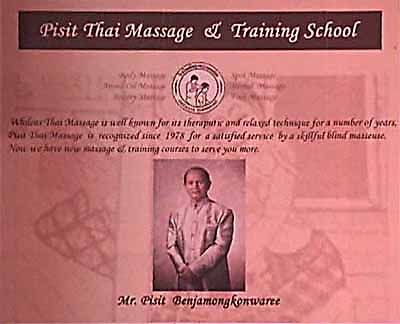
Many of these blind therapists came from poor farming families, where their disability made them a liability instead of an asset to the farms. If not from farms, typically they were from poor families. Ajahn Pisit had made it possible for many of these blind people to earn more money than the rest of their families, and most of therapists actually sent money to their poorer loved ones.
His school was a completely different scene than Wat Po. Wat Po gave out certificates to non-bodyworkers who were basically taking the class like a hobby...in fact, it was difficult not to receive certification. A British woman who was in my group and was so lost that I would cringe when she touched me received a certificate.
When I first walked in Pisit's school, two Italians were fighting with one of the staff over them failing the course and there not being enough time to repeat it before their visa expired. "Too bad," they were told. "Try harder next time." Very old school, I thought, which was perfect for someone really seeking knowledge as a primary motivation.
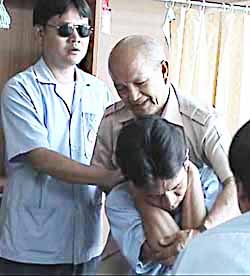 Ajahn Pisit instructs the blind as only he knows how. |
I walked into Pisit's school not looking to get a certificate, but as a truly motivated student who wished only to hone his craft. My attitude made me a big favorite of Ajahn Pisit's right away, as most of the Westerners were only concerned with securing certification and drove the staff crazy with their talk about it. I just dug in and practiced so hard that I would have to ice my thumbs nightly (yes, you can do this...fill a wine glass with ice, then water, and then your thumbs...you might get some sleep and be able to work the next day).
I spent over three months training at his school everyday, spending additional money to massage his blind therapists in my spare time outside of class so they could continue to correct and expand my technique. My attitude and generosity was rewarded a thousand times over, as I made friends with "Yang Kiat", one of Ajahn Pisit Benjamongkonwaree's top massage therapists.
Yang Kiat and I would sit outside the school on a bench in a hallway day after day without talking much. It was hard to tell if he was a massage therapist or a blind helper at the school because he didn't where the blue shirt uniform the others wore. With his long hair and stoic attitude, he was someone I gravitated towards out of curiosity. I blurted on the bench at one point that he looked like a rock-star. To my amazement, he shot back to me in pretty good English that he appreciated the compliment, but that as a musician, he was only writing songs for commercials on the radio.
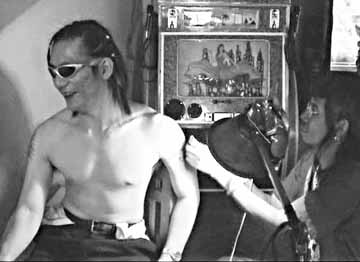 Yang Kiat gets a tattoo of a Garuda or a Thai "Kut" from the talented Mr. May with some of the money he earned from tutoring me. I am off camera, asking if it hurts. |
I came to find out that he was the best massage therapist at Pisit's school and didn't wear the uniform because he had too much style to be bothered with such mundane details. I begged him to tutor me privately, and he accepted my request after feeling me out for a couple of weeks. We had such a good working relationship that he was assigned to teach my advanced "Therapeutic Acupressure For Local Pain" course at Pisit, one on one. Of course, I had to pay a bit more for this.
What can I say? I lucked out. Yang Kiat is the most amazing bodyworker I have ever met, having mastered both the Northern and Bangkok styles of Thai Massage, countless routines of two person stretches, and numerous treatments for all types of conditions. I trained with Yang Kiat privately for almost three months outside of the blind school at his apartment. Needless to say, my thumbs were in excruciating pain from time to time...ice, ice, ice.
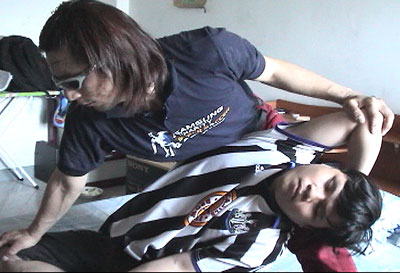
Yang Kiat also took me to his favorite Thai Massage establishments in Bangkok. Where does a blind Thai Massage expert go to get a Thai Massage? He took me to a number of his favorite places, explaining and teaching me the techniques from the various Thai Massage masters we visited. In the process, I sampled many different versions of the two styles in combination from some of Bangkok's best.
I also learned advanced forms of Ajahn Pisit's routines and treatments from Yang Kiat. With his help, I actually received certification from their school in both massage routines and pain therapy. Ironically, having not cared about the certificates, I received two of them.
Ajahn Pisit's six position foundation routine in Bangkok style Thai Massage is treatment enough to fix any structural injury that is not related to torn cartilage or tendons. It is also an energetic treatment without parallel; it balances and circulates energy in the body as well as any acupuncture treatment available.
Yang Kiat's supplemented Ajahn Pisit's six position foundation routine with an array of sophisticated techniques and stretches to provide a client with the greatest range of possibility. Yang Kiat fixed my most problematic injuries using these techniques to the point where I felt confident that years of untold damage from training while injured had been corrected.
In the meantime, Ajahn Pisit retired and his daughter moved to Japan and "greener" pastures. She had married a Japanese national and was definitely intrigued by the possibility of having a school funded by Japanese yen as opposed to Thai bhat.
I left Bangkok, armed with this array of technique to unleash on Americans.
Upon returning, amazing successes piled up upon my return, but I also heard a lot of the same crying in the process. Yang Kiat's and Pisit's methods were strong medicine, much like Dr. Zheng's. Clients would moan and fret about receiving treatments. One client would even hyper-ventilate before I even started in anticipation of what was to follow. It was not as bad as before, but it was still a problem.
I knew I had to soften things up to make the treatments more palatable for American sensibilities. I also wanted to review more with Yang Kiat, so I went back to Thailand one more time.
Chiang Mai
The Great, Soft North
In 2006, I returned to Thailand to study with Yang Kiat again. We expanded the number of therapy routines dealing with very problematic situations, more complicated routines that could only be introduced after an understanding in the more basic therapy routines had been accomplished.
These sessions were incredibly fruitful and left me with more material than I could possibly digest in the next few years. Having finished this, Chiang Mai was next on the agenda.
The average American does not hear much about Chiang Mai, but on the international traveler circuit Chiang Mai is well known for its cheaper-than-Bangkok prices, laid-back atmosphere, and variety of recreational activities. Many organized tours now travel to Chiang Mai for a combination of vacation and massage instruction. With a number of great institutions teaching massage in Chiang Mai, it is definitely worth the trip.
The word in Bangkok was that the Shivagakomarpaj Old Medicine Hospital was the most reliable institution for study. After inspecting all of the schools around town and quizzing some local Thai's, I concurred with this assessment.
As it turns out, it is an amazing experience to train there. The teachers spoke perfect English, executed the routines with precision, and piled on the material so hard and fast that I was left gasping at the task of keeping up with the material. One talented Scottish bodyworker would freak out daily and scream at them, "You are going too bloody fast!" The less knowledgeable of the bodyworkers there did not understand his concerns, but I did. The amount routine they cram in the time you are there is mind-boggling, IF YOU INTEND TO MASTER IT.
The routine they teach is their strongest selling point as well; it is so thorough that it can be used as an excellent preliminary massage prior to doing more rigorous Bangkok style techniques for therapy on any body part. You can take any section of this massage and use it to prepare that area of the body for more rigorous therapy techniques.
I kept a fairly low profile at the Old Medicine Hospital, but that didn't stop the instructors from constantly quizzing me about where I had studied previously. They were pretty open to hearing about Yang Kiat's stronger methods, and few of them actually had me work on some more problematic injuries that their massage failed to address. Their program was excellent, and I was happy to receive certification and move on.
Mama Lek's Nerve Touch School was next on the tour. Jack, Mama Lek's son who taught classes there, is one of the best bodyworkers I have ever seen in action...in fact, he is unbelievable. He seamlessly moved through routines and stretches in a way that I had only seen in Yang Kiat. Lacking the visa time to stay longer, I received their most bare bones certification and intend to return some day to study Jack's method more thoroughly.
Jack told me that these are the two original schools of Northern Style Chiang Mai massage, and many of their students have opened up the newer schools in Northern Thailand. Hearing this, I felt little need to further explore Chiang Mai for technique and returned home.
Here and Now in the San Francisco Bay Area
At present, I am mainly using the Shivagakomarpaj routine with first time clients. When I find embedded injuries during this routine, I will give the client the opportunity to use Yang Kiat's and Pisit's techniques for therapy. It is up to the client to decide the pain-threshold of the treatment, not me. In the past, I would just fix the client, regardless of how painful the treatment.
For people who need deeper routines to fix their ailments, I can either supplement this routine with pieces of the Pisit routine or just do the entire Pisit routine if the client is ready to receive it. A taste for strong medicine and the will-power to receive it is all you need.
